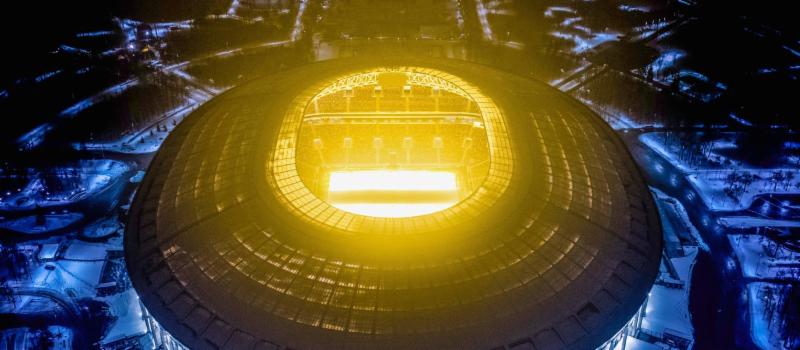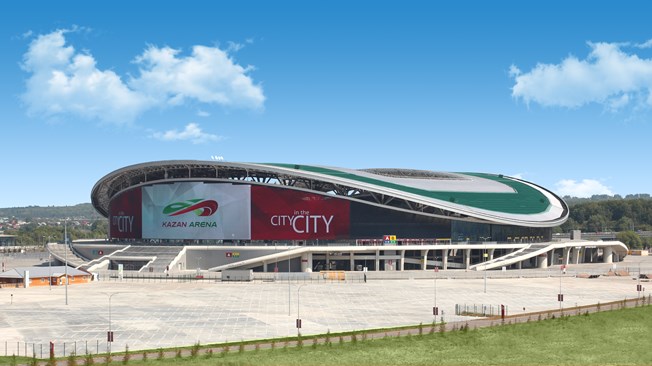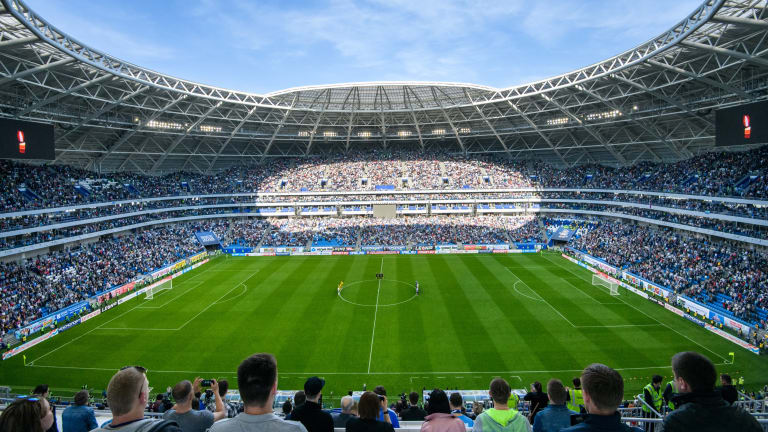This year’s World Cup is being played in Russia, with 12 stadiums in 11 cities hosting matches. Overall, Russians spent $10 billion in preparation for the tournament on stadiums and related infrastructure. Here’s a look at the stadiums–as seen through Soviet Russia lens.
The outlay of capital and the welcoming of visitors for the greatest event in world soccer is a far cry from the days of the Soviet Union. Roughly from the Bolshevik revolution of 1917 to the fall of the Berlin Wall in 1989, the Communist Party dominated Russia. The governmental structure was a hierarchical and highly structured system of bureaucratic rule.
In a nod to that period in Russian history, let’s put the 2018 World Cup stadiums into their proper Soviet categories:
General Secretary of the Communist Party The leader of the party, and the country: the top of the Soviet leadership pyramid. From Lenin to Gorbachev, the top man.
Luzhniki Stadium – Moscow – Capacity: 81,000
The central stadium of the tournament, and therefore our top stadium, has to be the historic Moscow stadium that hosted both the 1980 Olympics and the 2008 Champions League final. It has been extensively remodeled for this year’s tournament, with the running track removed and two tiers of seating added, while still retaining its historical facade. Luzhniki (shown above) will host matches in the group stage, round of 16, a semi-final, and this year’s World Cup final. It is the kind of behemoth perfect for a final, fittingly bringing the world to the seat of the Kremlin.
Underneath the General Secretary, the government of the old Soviet Union was complicated, but the country was largely run by the Central Committee of the Communist Party.
Secretariat At the helm of the central Committee was the Secretariat, the leading body within the Central Committee, made up of a small group of high-level officials.
What stadiums would be in this small but elite group? Those that are unique, special or new.
Kazan Arena – Kazan – Capacity: 45,000
Kazan’s beauty will host four group stage matches, one Round of 16 tie and a quarter-final. Designed by Populous and shown above, architects of Wembley Stadium and the Emirates in London, it resembles a water lily from above, provides intimacy with its compact interior and features 3,700 square foot high definition screen — biggest outdoor screen of its kind in the world.
Nizhny Novgorod Stadium – Nizhny Novgorod – Capacity 45,331
This new stadium, set at the confluence of two rivers, is meant to resemble the shimmering water that surrounds it in a variety of blues. It is a gorgeous combination of classical style and modern design, with columns fronting a semi-transparent facade and a dramatic, patterned, canopy roof. Set in the city that was known as Gorky during the Soviet era, after writer Maxim Gorky, the stadium will host group stage, round of 16, and a quarter-final match.
Saint Petersburg Stadium – St. Petersburg – Capacity: 64,287
Despite a series of delays in construction (reported to be completed over 500 percent late, and 500 percent over budget), the stadium in Putin’s hometown is nonetheless spectacular. Designed by Japanese architect Kisho Kurosawa, the stadium on Krestovsky Island has a retractable roof and a sliding pitch, and is home to FC Zenit St. Petersburg. The other semi-final will be played here, as well as group stage, a round of 16 match, and the third place game.
The next category of the ruling structure of the old Soviet Union was the Politburo.
Politburo Just below the Secretariat in power, this was the political bureau of the Central Committee; in practice, the ruling body of both the Communist Party and the Soviet Union.
In this category, there are some very interesting stadiums. Perhaps a little less exciting than those in the Secretariat, they do boast some unique features and modern design.
Fisht Stadium – Sochi – Capacity: 47,659
This stadium hosted the opening and closing ceremonies of the 2014 Winter Olympics and Paralympics. Another Populous venue, it has been adapted for multiple uses over the years, most notably when the roof was removed for soccer, first showcased in the 2017 FIFA Confederations Cup.
Samara Arena – Samara – Capacity: 44,807
Samara was once home of the Soviet space program and this stadium, also known as Cosmos Arena, looks as if it could blast off with the right propulsion. This stadium (shown above) was built for the World Cup and has consistently run behind schedule. It features covered, heated seating areas under its low-slung roof.
Spartak Stadium – Moscow – Capacity: 45,360
Built for both for the tournament and as a permanent home for Spartak Moscow and opened in 2014 after long construction delays, this stadium looks much like the Allianz Arena in Munich. It has a quality soccer atmosphere inside and provides a second world-class stadium in the capital city.
Volgograd Arena – Volgograd – Capacity: 45,568
In the city once known as Stalingrad, this 1950s stadium has been remodeled significantly to make it into a more vibrant venue. Steel girders have replaced slabs of concrete, allowing natural light onto the pitch. Its exterior design is somewhat reminiscent of Nizhny Novograd, but the interior bowl remains much the same.
Underneath the Politburo, the political rulers of the Soviet Union, sat the apparatchiks, the professional functionaries, the day-to-day administrators of the communist system.
Apparatchiks James Billington, Harvard Russian historian, described an apparatchik as “a man not of grand plans, but of a hundred carefully executed details.”
All important to the functioning of the World Cup, these stadiums are the workhorses of the tournament-less special, but important to functionality.
Ekaterinburg Arena – Ekaterinburg – Capacity: 35,696
A thousand miles from Moscow, this stadium was redeveloped especially for this summer’s World Cup with massive temporary stands tacked onto both ends of a classic stadium. Temporary seating additions can be an elegant solution, but here 12,000 temporary seats have been added to meet FIFA requirements, and they overwhelm the classical facade and look unnatural.
Kaliningrad Stadium – Kaliningrad – Capacity: 35,212
The westernmost host city in the tournament, Kaliningrad is located in a Russian enclave between Lithuania and Poland on the Baltic Sea. The new ground was built on marshy ground, a source of delays, and is not particularly attractive. It will be reduced to a 25,000-seat venue, and part of the roof will be removed, after the World Cup.
Mordovia Arena – Saransk – Capacity: 44,442
This stadium is another new one in the Allianz mold, though its extensive exterior and interior use of orange color is unique. With turf being imported from Canada and under pitch heating, it will be the permanent home of FC Mordovia Saransk, recently promoted to the Russian second division, though the upper level will be removed to reduce it to a capacity of 28,000.
Rostov Arena – Rostov – Capacity: 45,145
Another new arena situated in the far western part of Russia near the Ukraine, in the early construction phase, intact shells from World War II were found on the building site. Reportedly the original plan had to be amended for financial reasons, but the result is still a high-quality arena. Local authorities hope to make it a shopping and dining destination after the World Cup, as it becomes the home of FC Rostov of the Russian Premier League.
From the all-powerful General Secretary to the necessary apparatchiks, in the Soviet-era Communist party, each comrade had a role to play. In the World Cup, each stadium has a role to play.
As in every World Cup, there is a great variety in stadiums-the very nature of the modern bidding process, and FIFA rules, insure a high standard, but the differing locales provide variety. This year, Russia is no different. It has polished its existing stadium gems, built new ones where needed, and from a facilities perspective, seems ready to host the world’s tournament.
Images courtesy FIFA.



